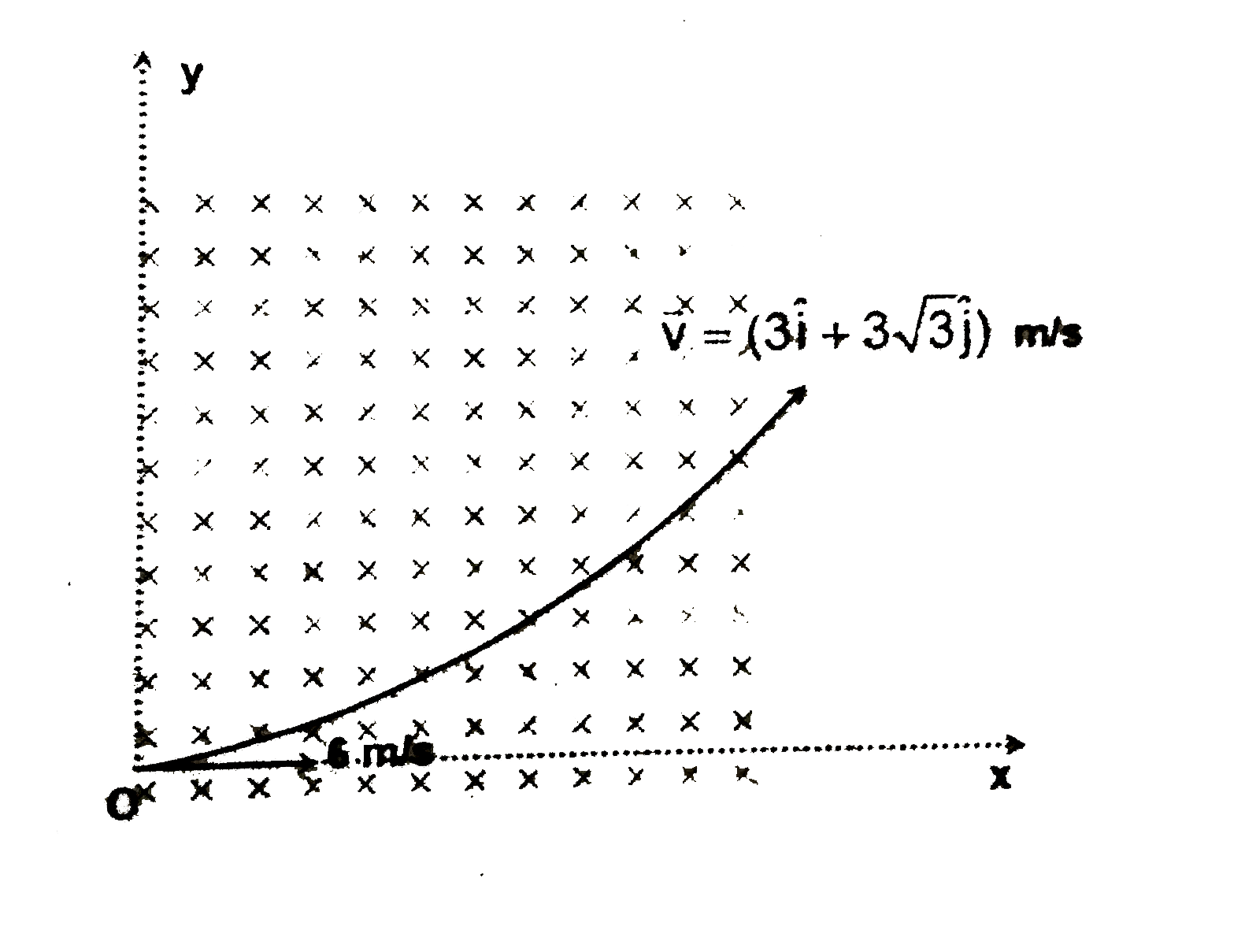A 2.0 kg particle has a velocity of →v1=(2.0ˆi−3.0ˆj)m/s, and a 3.0kg particle has a velocity →v2=(1.0ˆi+6.0ˆj)m/s. How fast is the center of mass of the particle system moving?
To find the velocity of the center of mass of the particle system, we can follow these steps:
Step 1: Identify the masses and velocities of the particles
We have:
- Mass of particle 1, m1=2.0kg
- Velocity of particle 1, →v1=(2.0^i−3.0^j)m/s
- Mass of particle 2, m2=3.0kg
- Velocity of particle 2, →v2=(1.0^i+6.0^j)m/s
Step 2: Use the formula for the velocity of the center of mass
The velocity of the center of mass →vcm is given by the formula:
→vcm=m1→v1+m2→v2m1+m2
Step 3: Substitute the values into the formula
Substituting the values we have:
→vcm=2.0kg⋅(2.0^i−3.0^j)+3.0kg⋅(1.0^i+6.0^j)2.0kg+3.0kg
Step 4: Calculate the numerator
Calculating the contributions from each particle:
- For particle 1:
2.0⋅(2.0^i−3.0^j)=(4.0^i−6.0^j)kg m/s
- For particle 2:
3.0⋅(1.0^i+6.0^j)=(3.0^i+18.0^j)kg m/s
Now, adding these two results together:
(4.0^i−6.0^j)+(3.0^i+18.0^j)=(4.0+3.0)^i+(−6.0+18.0)^j=7.0^i+12.0^jkg m/s
Step 5: Calculate the denominator
The total mass is:
m1+m2=2.0+3.0=5.0kg
Step 6: Calculate the velocity of the center of mass
Now, substituting back into the formula:
→vcm=7.0^i+12.0^j5.0=(1.4^i+2.4^j)m/s
Final Answer
Thus, the velocity of the center of mass of the particle system is:
→vcm=1.4^i+2.4^jm/s
---
We have:
- Mass of particle 1, m1=2.0kg
- Velocity of particle 1, →v1=(2.0^i−3.0^j)m/s
- Mass of particle 2, m2=3.0kg
- Velocity of particle 2, →v2=(1.0^i+6.0^j)m/s
The velocity of the center of mass →vcm is given by the formula:
→vcm=m1→v1+m2→v2m1+m2
Substituting the values we have:
→vcm=2.0kg⋅(2.0^i−3.0^j)+3.0kg⋅(1.0^i+6.0^j)2.0kg+3.0kg
Calculating the contributions from each particle:
- For particle 1:
2.0⋅(2.0^i−3.0^j)=(4.0^i−6.0^j)kg m/s
- For particle 2:
3.0⋅(1.0^i+6.0^j)=(3.0^i+18.0^j)kg m/s
(4.0^i−6.0^j)+(3.0^i+18.0^j)=(4.0+3.0)^i+(−6.0+18.0)^j=7.0^i+12.0^jkg m/s
The total mass is:
m1+m2=2.0+3.0=5.0kg
Now, substituting back into the formula:
→vcm=7.0^i+12.0^j5.0=(1.4^i+2.4^j)m/s
Thus, the velocity of the center of mass of the particle system is:
→vcm=1.4^i+2.4^jm/s
Topper's Solved these Questions
- CENTRE OF MASSBOOK - ALLENCHAPTER - CENTRE OF MASSEXERCISE - EXERCISE-I
40 Videos
- CENTRE OF MASSBOOK - ALLENCHAPTER - CENTRE OF MASSEXERCISE - EXERCISE-II
43 Videos
- BASIC MATHEMATICS USED IN PHYSICS &VECTORS BOOK - ALLENCHAPTER - BASIC MATHEMATICS USED IN PHYSICS &VECTORS EXERCISE - EXERCISE-IV ASSERTION & REASON
11 Videos
- ELASTICITY, SURFACE TENSION AND FLUID MECHANICSBOOK - ALLENCHAPTER - ELASTICITY, SURFACE TENSION AND FLUID MECHANICSEXERCISE - Exercise 5 B (Integer Type Questions)
3 Videos
Similar Questions
A force →F=(2ˆi+ˆj+ˆk)N is acting on a particle moving with constant velocity →v=(ˆi+2ˆj+ˆk)m/s. Power delivered by force is
View Solution
A particle of charge 'q' and mass 'm' enters a uniform magnetic field region →B=−Bˆk at origin 'O' with a velocity →v0=6ˆi m/s and after some time it exist the magentic field region with a velocity →v=(3ˆi+3√3)m/s as shown. The time interval for which the particle has moved in the magnetic field region is
View Solution
Knowledge Check
A 120 g mass has a velocity →v=2ˆi+5ˆjms−1 at a certain instant. Its kinetic energy is
A3 JB4 JC5 JD1.74 JA particle of mass 1 g moving with a velocity →v1=3ˆi−2ˆjms−1 experiences a perfectly in elastic collision with another particle of mass 2 g and velocity →v2=4ˆj−6ˆkms−1. The velocity of the particle is
A2.3ms−1B4.6ms−1C9.2ms−1D6ms−1
Two particles of masses m and 2 m has initial velocity →u1=2ˆi+3ˆjms and →u2=−4ˆi+3ˆjms Respectivley. These particles have constant acceleration →a1=4ˆi+3ˆj(ms2) and →a2=−4ˆi−2ˆj(ms2) Respectively. Path of the centre of the centre of mass of this two particle system will be:
View SolutionA particle is moving with a constant acceleration →a=ˆi−2ˆj+2ˆkm/s2 and instantaneous velocity →v=ˆi+2ˆj+2ˆkm/s, then rate of change of speed of particle 2 second after this instant will be :
View SolutionA particle starts from the origin at t=Os with a velocity of 10.0ˆjm/s and moves in the xy-plane with a constant acceleration of (8ˆi+2ˆj)m/s−2. What time is the x-coordinate of the particle 16m?
View SolutionA particle of mass 2kg is moving in free space with velocity →v0=(2ˆi−3ˆj+ˆk)m/s is acted upon by force →F=(2ˆi+ˆj−2ˆk)N. Find velocity vector of the particle 3s after the force starts acting.
View SolutionA particle starts from the origin at t = 0 s with a velocity of 10.0ˆj m/s and moves in plane with a constant acceleration of (8ˆi+2ˆj)ms−2. The y-coordinate of the particle in 2 sec is
View SolutionA particle has an initial velocity 3ˆi+3ˆj and acceleration of 0.41ˆi+0.3ˆj. Its speed after 10s is
View Solution
